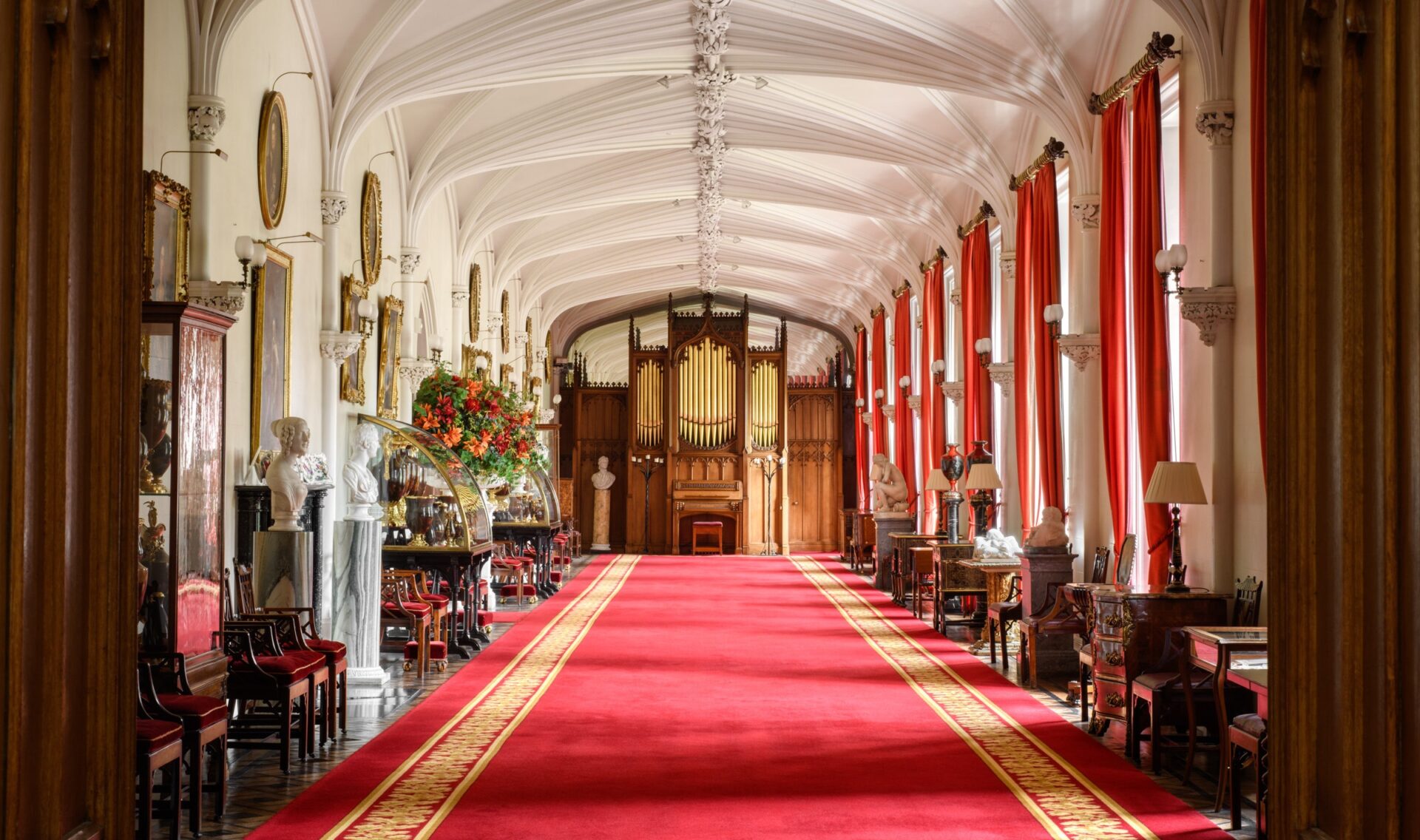The Long Gallery may not be the homeliest room in the palace, but it is perhaps the most impressive. This room was designed for purpose and recreation, a place where ladies could walk up and down when the Scottish weather prevented them from taking a turn in the grounds. Had you been a visitor to the palace during the time of the Gowries, or earlier generations of the Murray family, the room would have looked very different. Before the palace was redesigned by the 3rd Earl, the walls of this room were decorated with medieval murals depicting hunting scenes, but due to a misunderstanding between the 3rd Earl, his architect, William Atkinson, and the Clerk of Works, the murals were sadly lost. But the gallery’s extraordinary proportions remain, and at 150 feet (45 metres) in length, the room remains the longest room of any private house in Scotland.
The room is reminiscent of a gallery with portraits running the length of the inner wall. But take a moment to observe the small painting on the easel to the right as you enter the room. This oil on panel shows the Long Gallery during the time of Queen Victoria’s visit. Painted by J. Gibb in the first quarter of the 1800s, it gives a precious insight into how the room was arranged and used during this period.
As you walk the length of the Long Gallery, many faces will look down upon you, most of whom are ancestors of the present family. On your left is a painting by Francesco Trevisani, and not Van Loo as the plaque says, of James Murray, the Jacobite Earl of Dunbar (circa 1690-1770). Raised in both a Protestant and Jacobite household, James Murray went on to become Secretary of State to James Francis Edward Stuart (the Old Pretender) who created him Earl of Dunbar in 1721, as well as Knight of the Thistle in 1725, and tutor to the Prince of Wales in June 1727.
At the far end of the gallery, is a portrait of Marjory Murray (The Hon. Mrs. Hay, d. 1768), daughter of the 5th Viscount, also painted by Francesco Trevisani (1656-1746) although the plaque underneath again mistakenly attributes the work to Dutch artist Van Loo. She married John Hay of Cromlix, the Jacobite Duke of Inverness. He was a courtier and army officer to King James VIII & III, otherwise known as The Old Pretender. The three-quarter-length portrait shows her in a white dress and blue wrap, arranging a vase of flowers at the table.
The work of Trevisani continues with his portrait of David, 6th Viscount Stormont (d. 1748). This half-length composition shows the 6th Viscount in a brown coat with a red and gold embroidered waistcoat. Along with Marjory and James, he too was a brother of the 1st Earl of Mansfield.
The Long Gallery has played host to many key moments in Scottish history. In 1651, King Charles II walked in procession along the gallery on the way to his coronation on Moot Hill. In 1716, The Old Pretender, James Edward Francis Stuart, came to Scone to be crowned and waited here for a coronation that was not to be, as he had to depart in haste when news of George I’s Hanoverian forces were approaching. Later, in 1842, this oaken floor was polished and used like an ice rink when the 4th Earl of Mansfield gave a curling demonstration to Queen Victoria and Prince Albert during their first ever visit to Scotland. Prince Albert was so captivated by the game that he agreed to become the Patron of the newly titled Royal Caledonian Curling Club.
Among the Long Gallery’s many treasures is the distinctive collection of Vernis Martin vases and ornaments. Originally part of a 120-piece set, the 70 pieces acquired at the beginning of the 19th century by the 4th Earl, are housed in four glass display cabinets, placed at intervals along the length of the gallery wall. The term ‘Vernis Martin’ is derived from the perfection of a transparent glazed varnish, introduced by the Martin family in France in the early 18th century. The vases, urns and covered cups that form the Vernis Martin collection are made from papier-mâché and bear silver-gilt mounts. The remaining 50 pieces were bought by the Tsar of Russia and kept at the Hermitage in Saint Petersburg until they vanished in 1917.
Placed in intervals along the Long Gallery are Chinese Export Padoukwood Open Armchairs, part of a seventeen-piece set, dating from the late 18th century. Each chair displays pagoda cresting and trellis-pierced backs and arms and are in the style of Chippendale.
Halfway down the gallery, in between a pair of windows, is a William IV Rosewood Teapoy. This small piece of freestanding, footed furniture was used to store expensive teas. If you look closely at the lock, you will see scratches where, at some point in its service, someone has tried to force the lock open.
Thoughtfully placed in the light from a window is a marble sculpture of Lady Susan Murray, the great-great-grandmother of the present Earl, when she was just 3 months old. This charming carving in Italian Carrara Marble by Sir Richard Westmacott RA (1775-1865) perfectly captures the innocence of the sleeping infant.
At the far end of the gallery is an organ, built in 1813 by Thomas Elliot, an English organ builder. It was given to Frederica, the wife of the 3rd Earl, for her birthday. It is in its original condition apart from the addition of an electric blower in 1969. It is rare to find an organ of similar age in Britain that has not, at some point, undergone major renovation or reconstruction. Although the pipes are corroded, the organ is still in full working order.
